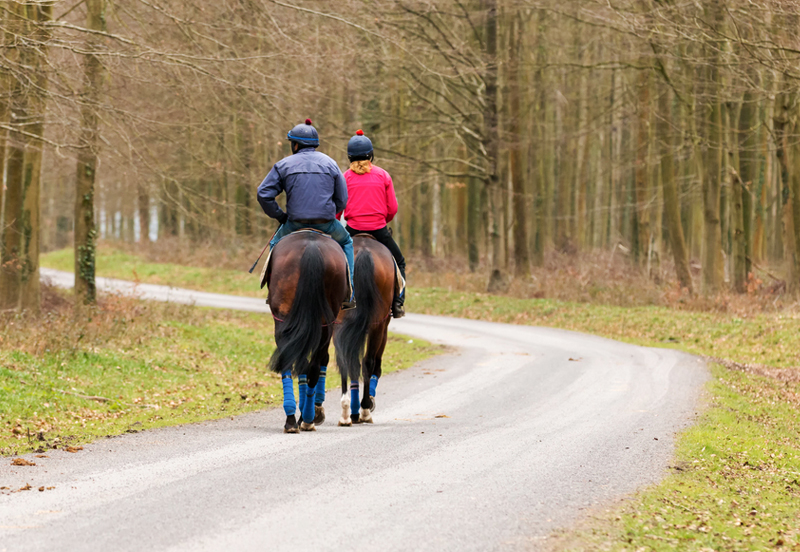
So you’re certain that an ex-racehorse is the right equine match for you. Now you need to work out how to achieve your ambition of trotting 20m circles, not re-enacting the 2.40 at Uttoxeter.
It goes without saying that owning an ex-racehorse isn’t for everyone, and is a commitment that you should only consider as a competent rider with the means to cover the costs associated with thoroughbred ownership.
Here’s our quick guide to starting the retraining process.
Do your horse homework
Having an insight into your horse’s previous experience is a good place to start. There are a few routes you may take to find an ex-racehorse. If you are buying directly from a trainer then ask them or the stable staff about your horse’s daily routine. If the sale is slightly more removed then take some time to research training methods and racing yard management, this will enable you to see the world through your horse’s eyes and pick out any potential issues.
Retraining racehorses will vary massively according to their history and your intended post-racing career; many ex-racehorses go on to achieve great careers in eventing.
A horse that has point-to-pointed as a family horse may have taken part in all sorts of activities and require little more retraining than any other new purchase. A six-year-old animal that has spent four years racing on the Flat is in for a big change, and the retraining schedule will have to reflect that.
Get your ex-racehorse a full MOT
Once you have an idea of the horse’s riding history, the best place to start is to have back, tack, and teeth checked.
The horse’s musculature is going to change hugely in the next year or so, so be prepared to have the saddler and chiropractor/physiotherapist out regularly to make sure that progress is even and balanced and not hampered by poorly fitting tack. They can also spot any issues with one side being more dominant than another, and give you advice on how to work with this as training continues.
Ex-racehorses need patience to retrain
Racehorses are trained to run and you will probably find that yours works in a pretty hollow outline. Changing this can be done in the same way as any other untrained horse; slow and steady steps with lots of patience.
Work slowly with taking up a contact as racehorses are trained to lean in to a contact and will see shortening the reins as an invitation to run faster.
Keep your hands apart and your contact light to avoid this, and sit up straight to prevent tipping your horse further on to the forehand; again, this is where having someone on the ground will help.
Your ex-racehorse may need schoolwork
You may want to start retraining with lots of schoolwork, especially if your ambitions lie in the show ring.
Be aware that thoroughbreds are very intelligent and easily bored; endless circles on a light contact may be livened up with some aerial acrobatics if your horse finds that they lack mental stimulation!
Mix things up with different shapes and transitions, and as soon as you are confident take your horse for a hack.
Get help retraining your ex-racehorse
Depending on your experience you may want to carry out the retraining process on your own, or you may want to delegate all or part of it to a professional. Whatever your intentions it is very beneficial to have someone on the ground who can help you and see riding problems before they affect the horse; even if this is just having someone to move trotting poles around!
Retraining of Racehorses have a list of instructors that they work with for clinics and training sessions; your horse may not be ready for these, but if the instructors can provide private lessons then they will be a good place to start.
Jockeys and stable staff are typically legged up while the horse is walking, so standing still to be mounted may be the first challenge you come across. Take your time, have patience, and don’t expect your horse to immediately stand perfectly square for you to get on.
I trained mine with a long step that meant that if he walked forward as I was getting on I didn’t have to worry about losing my height advantage and having to pull myself up. Over time he walked forward less and less, and got to the stage where I could mount from the ground or from a narrow step.
A quiet horse to buddy up with
When confident you’re ready, If you can, arrange for a quiet horse to accompany you on your first ride.
Try a circular route with light traffic and a few (but not too many) novelties. Get your horse to walk behind, in front of, and aside the other horse, and practice walking away while he or she stands and vice versa.
These will all be valuable for when you ride independently. Traffic probably won’t be a problem but your horse may not have seen road markings.
Give plenty of praise every time they do something good or brave. Even if you want your horse to compete, it is also great for your horse to see hacking as a pleasure, and this can start from the first outing.
Summary
Every racehorse is different to retrain, and along the way you will undoubtedly come across challenges. Make best use of professional services, and sign up to Retraining of Racehorses access to coaching and training.
Having a network of other thoroughbreds at various stages of their retraining will give you inspiration and advice along the way.
Have patience, be kind (but firm), and approach your ex-racehorse as you would any green horse. And above all else- enjoy. You may not event at four star level, but every horse that has a happy life after racing is a major success.
Please share you own experiences retraining an ex-racehorse as we’d love to hear them.


